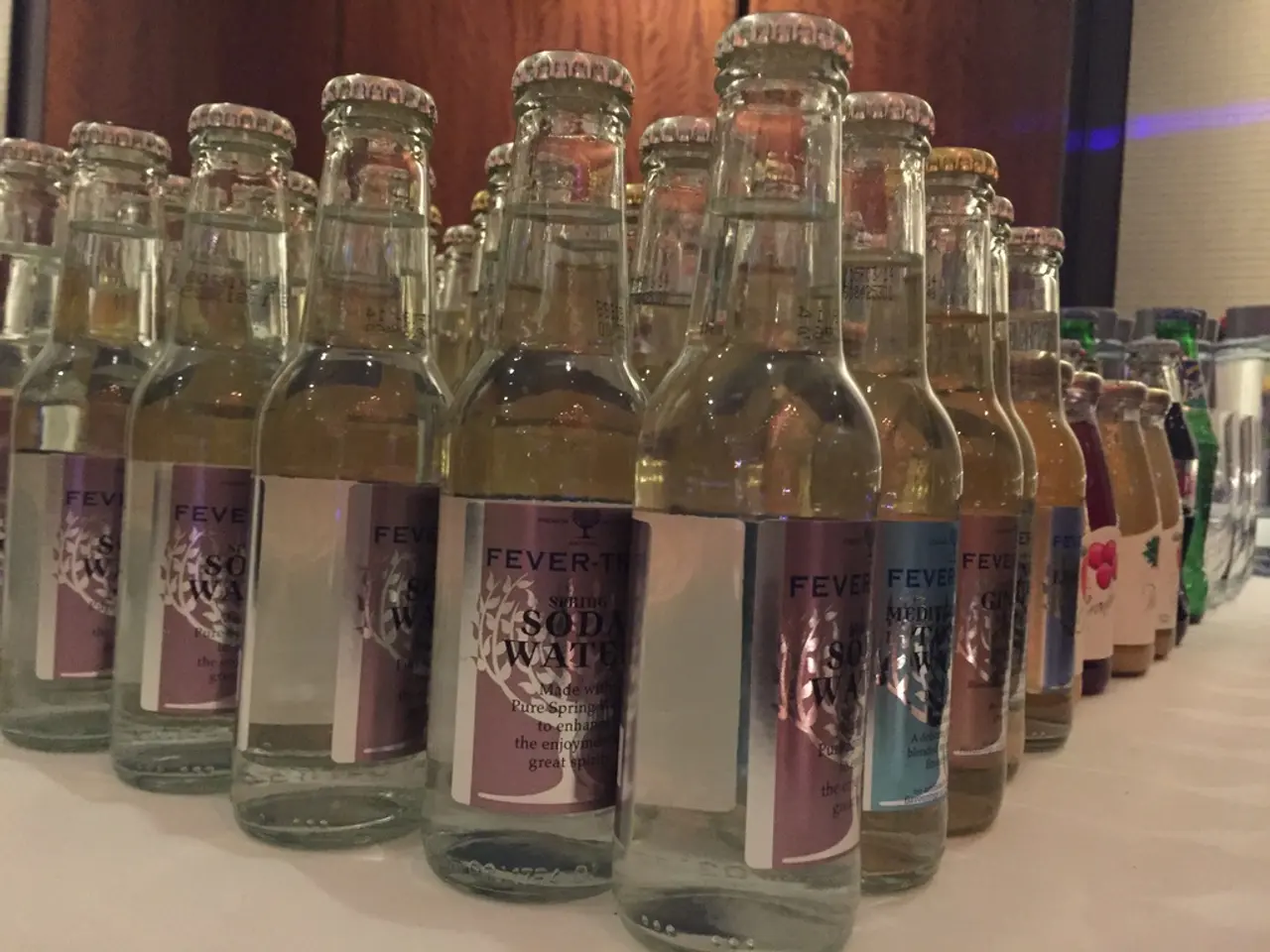Tonic water's primary ingredient, quinine, examines safety considerations, potential side effects, and potential advantages in consumption.
In the realm of popular beverages, tonic water has long been associated with a unique bitter taste and a perceived health benefit. However, a closer look at the scientific evidence reveals a different story.
Tonic water contains quinine, a compound derived from the bark of the cinchona tree, native to central and South America, the Caribbean, and western Africa. This substance gives tonic water its distinctive bitter taste and has been historically used to treat malaria. However, the current scientific evidence does not strongly support the use of quinine in tonic water for leg cramps or restless legs syndrome (RLS).
The concentration of quinine in tonic water is much lower than the medical doses used to treat muscle cramps. This low dose is unlikely to have a significant therapeutic effect for leg cramps or RLS. While quinine was historically used in higher doses as a prescription medication to reduce muscle cramps, its use has declined due to potential side effects and limited evidence of benefit.
Research on muscle cramps and their causes is still evolving, and mechanisms are not fully understood. Treatments like quinine target some proposed neural causes but are not universally effective. Alternative remedies such as pickle juice or mustard may work through other mechanisms but do not involve quinine and have limited robust clinical evidence themselves.
For restless legs syndrome specifically, quinine is not recognized as a standard or evidence-based treatment. The FDA does not approve quinine as a treatment for certain health conditions due to potential health complications.
It is important to note that quinine may have adverse effects at therapeutic doses. The side effects of quinine as a medication can be more severe, including kidney damage, severe allergic reactions, electrolyte imbalance, vision or eye issues, problems with bleeding, thrombocytopenia, lung toxicity, and decreased blood platelets. Pregnant or breastfeeding women, people with abnormal heart rhythm, liver or kidney disease, low blood sugar, and certain other medical conditions should avoid quinine.
Manufacturers must label tonic water to show the presence of quinine. However, some unapproved products containing quinine do not state the associated risks in their safety information.
In conclusion, tonic water’s quinine content is too low to provide significant relief for leg cramps or RLS, and current research does not support its use for these conditions. Anyone considering quinine for muscle cramps or RLS should consult a healthcare professional due to safety concerns and uncertain efficacy.
It's also worth noting that tonic water is a carbonated soft drink that may contain sugar, has little nutritional value, and could lead to an unnecessary increase in calorie consumption. People who regularly drink tonic water should consider the extra sugar and calories they are consuming.
The FDA has approved up to 83 parts per million of quinine in carbonated beverages, but it does not endorse tonic water as a health drink. Quinine does not have any major benefits as a substance in tonic water, and it should not be mistaken for a healthful drink. The focus should be on maintaining a balanced diet and seeking professional advice for health concerns.
- Aq tonic water's unique bitter taste, historically attributed to health benefits, doesn't hold strong support in current scientific evidence.
- The compound quinine, derived from the cinchona tree, found in tonic water, is responsible for its distinctive taste and was used to treat malaria.
- Quinine's presence in tonic water reduces its concentration significantly, making it unlikely to have a significant therapeutic effect for leg cramps or restless legs syndrome (RLS).
- Quinine, historically used in higher doses as a medication for muscle cramps, has seen a decline due to potential side effects and limited evidence of benefit.
- The scientific understanding of muscle cramps and their causes is evolving, with proposed neural causes targeted by treatments like quinine but not universally effective.
- Alternative remedies for muscle cramps, such as pickle juice or mustard, may work through other mechanisms and do not involve quinine.
- Quinine is not recognized as a standard or evidence-based treatment for RLS.
- The FDA does not approve quinine as a treatment for certain health conditions due to potential health complications.
- Quinine may have severe adverse effects at therapeutic doses, including kidney damage, severe allergic reactions, and vision problems.
- Pregnant or breastfeeding women, people with certain medical conditions, and those with conditions like abnormal heart rhythm, liver or kidney disease, low blood sugar, and specific other health issues should avoid quinine.
- Manufacturers must label tonic water to show the presence of quinine, but some unapproved products may not include associated risks in their safety information.
- Tonic water is a carbonated soft drink with little nutritional value and potential for unnecessary calorie consumption.
- The FDA allows up to 83 parts per million of quinine in carbonated beverages, but it does not endorse tonic water as a health drink.
- Quinine does not have major health benefits as a substance in tonic water and should not be mistaken for a healthful drink.
- The focus should be on maintaining a balanced diet and seeking professional advice for health concerns.
- Obesity is a type of chronic disease related to excess weight and unhealthy eating habits.
- Type 2 diabetes, a form of diabetes, is a chronic health condition characterized by high blood sugar levels due to insulin resistance and the body's inability to produce insufficient insulin.
- Multiple sclerosis (MS) is a neurological disorder in which the immune system attacks the protective sheath that covers nerve fibers, causing communication problems between the brain and the rest of the body.
- Restless leg syndrome (RLS) is a sleep disorder characterized by an irresistible urge to move the legs, usually occurring during resting or inactivity.
- Age-related macular degeneration (AMD) is a degenerative eye disease that affects the central part of the retina, the macula, and can lead to vision loss.
- Depression is a mental health disorder characterized by persistent feelings of sadness, hopelessness, and a lack of interest in activities.
- Psoriatic arthritis is an autoimmune disorder that causes inflammation and painful swelling in and around the joints, often affecting those with psoriasis.
- COPD (Chronic Obstructive Pulmonary Disease) is a chronic respiratory condition marked by persistent symptoms and Airflow obstruction due to inflammation.
- Science has made significant advancements in the understanding and treatment of various medical conditions, including neurological, mental, and autoimmune disorders.
- Supplements play a crucial role in maintaining health and managing multiple health conditions like diabetes, arthritis, and cardiovascular diseases.
- Proper sleep is essential for maintaining overall health and wellness, especially for workplace wellness and managing chronic diseases like obesity and diabetes.
- Science plays a significant role in understanding and making advancements in medical conditions, including digestive health, eye health, hearing loss, and mental health disorders.
- Fitness and exercise are crucial for maintaining cardiovascular health, weight management, and controlling various chronic diseases like diabetes, obesity, and arthritis.
- Mens health is an important aspect of overall health and wellness, focusing on conditions specific to men such as prostate issues, testosterone levels, and sexual health.
- Skin care has gained significant importance in health and wellness, as it affects various skin conditions and aging processes.
- Various therapies and treatments like physical therapy, occupational therapy, and psychotherapy help manage chronic diseases, pain, and mental health disorders.
- Nutrition plays a vital role in maintaining health and managing various chronic diseases, including obesity, diabetes, and autoimmune disorders.
- Womens health focuses on conditions specific to women, such as menstrual disorders, pregnancy, postpartum health, and breast health.
- Parenting involves learning about child development, providing emotional and physical support, and making informed choices regarding child health and wellness.
- Managing weight and maintaining a balanced diet are essential aspects of healthy cooking and lifestyle, affecting various health conditions like obesity, diabetes, and cardiovascular diseases.
- Financial planning and wealth management are crucial for maintaining a healthy lifestyle, covering aspects like income, expenses, savings, and managing debt.




